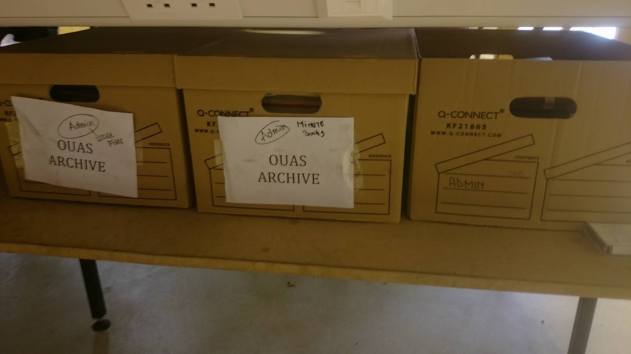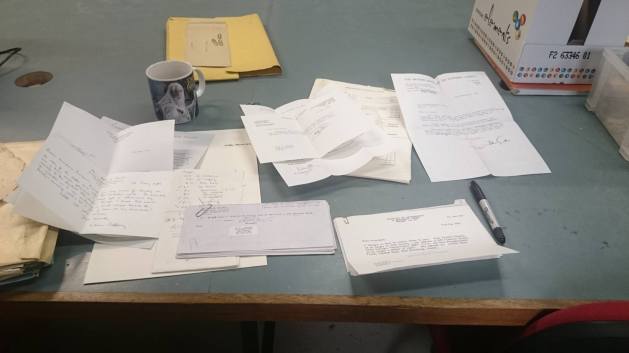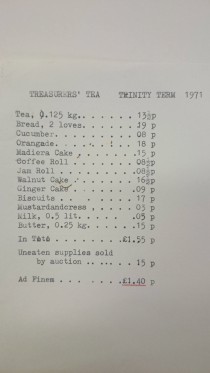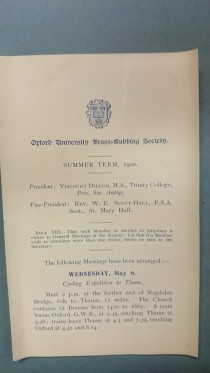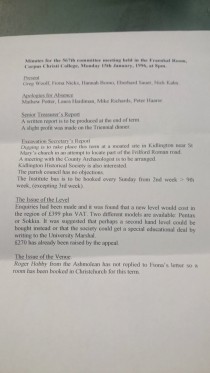Due to being unable to attend last week’s session with the archive, I have decided to write a post combining discoveries from both the latter (using information from my fellow archivists) and this week. Week 3 was mainly characterised by the uncovering of the minute books, the oldest of which dated to 1914.
We were surprised to learn that what we now know as the OUAS had originally been the Brass Rubbing Society, begun in 1893 with a purpose pertaining to: “…the study and better preservation of Monumental Brasses. During the eight years of its existence the Society has held Meetings, organised Excursions, published the two periodicals known as the Oxford Journal of Monumental Brasses, and the Oxford Portfolio of Monumental Brasses, and collected sums of money for the preservation and relaying of loose Brasses in the Diocese of Oxford.”
In 1899 the decision was made to change the name of the society to the Oxford University Antiquarian Society: “…while the study and preservation of Monumental Brasses and Slabs continue to be among its chief objects, the society also concerns itself with Architecture, Archaeology and various Antiquarian subjects.” This group considered their three main activities to be the hosting of informal meetings in college rooms for archaeological discussions; excursions to locations in and nearby Oxford; and a continuing of their contemporary publications.
Returning to the 1914 minute book, we were thrilled to see that rather than containing endless notes on society meetings, it was filled with diary-like entries of the excursions and trips the group of gentlemen (this was when membership was exclusive to men) had undertaken. There were a few splendid black-and-white images of the group posing formally in front of historic buildings, with names of individuals scrawled underneath. For example, one of these (see image above) was from an excursion to one Broughton castle on June 7th. Another showed a merry-looking party visiting Appleton Manor on May 15th, the group standing in front of the “especially fine” 12th century doorway of the building.
We intend to eventually obtain individual boxes for each of the minute books and also scan in all such photographs inside. The style of recording in these earlier books provide a highly personalised and detailed narrative of the society’s activity in the earlier decades of the 20th century. It would be very interesting to look at how we may have been affected by the onset of the First World War in 1914, and whether there is mention of these events within the archive. To find out, it will be a helpful starting point to examine and compare the pre- and post-war material.
There was also a beautifully presented, chronologically ordered box of termcards mostly dating from the 1940s through to the 1980s, with a few ‘rogue’ examples from the early 1900s and 1990s.
It has become apparent to us that the archive is partially ordered, although the extent of this is not yet clear. In other words, someone has been through it before and aimed to organise it, as we have found groups of similar material together in each box. This week, we found a document that provided proof of this. Dating to 1993, the sheet stated ‘advice’ for OUAS members working with the archive, and it seemed as though at this time OUAS members were undertaking a similar exercise to us and trying to learn more about the history of the society. Information on this project ends there, so we are very excited at the prospect of uncovering more information on what efforts have been made in the past to explore our history.
Another find was a huge envelope labelled ‘triennial dinners’, containing items ranging from menus to handwritten invitations, acceptance (and rejection) letters, and event cost assessments. This got us talking about when this grand tradition ended, into which a huge amount of work would go towards the hosting of a feast with invitations for life members and esteemed archaeologists, many of whom would give short speeches during the course of the dinner. One guest list from the 50th Anniversary Dinner in November 1969 (see image) boasted an impressive set of names: Stuart Piggott, Colin Renfrew and Christopher Hawkes were among the acceptances, and Sheppard Frere expressed his sad regrets at being unable to attend in a wonderfully eloquent apology note addressed to the society.
My favourite ‘archaeological find’ of the week however came in the form of an envelope which had been scribbled on through the years but was originally titled ‘essay’, and addressed to the eminent anthropologist and professor of Social Anthropology at Oxford from 1946-1970, E.E. Evans Pritchard. How this ended up in the OUAS archive, we have no idea (perhaps it was one of the committee that had sent the essay?) but it entertained me greatly to think about the days before email when all essays would have been sent by post; somehow this has a far more personal quality than sending a rushed 4am email attachment.
OUAS IT Rep and Archivist,
Katy Allen





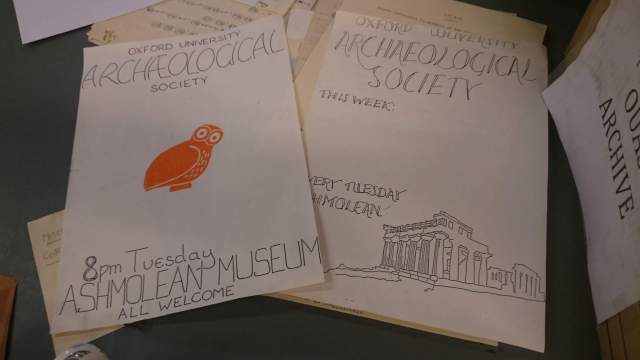 While this blog has been silent, the archives project has continued as normal! In spite of exams at the end of last term, we have pushed forward with the sorting of our documents. This term, sorting has ended and we are looking forward to moving on to digitising and bringing the archive to its final form.
While this blog has been silent, the archives project has continued as normal! In spite of exams at the end of last term, we have pushed forward with the sorting of our documents. This term, sorting has ended and we are looking forward to moving on to digitising and bringing the archive to its final form.



